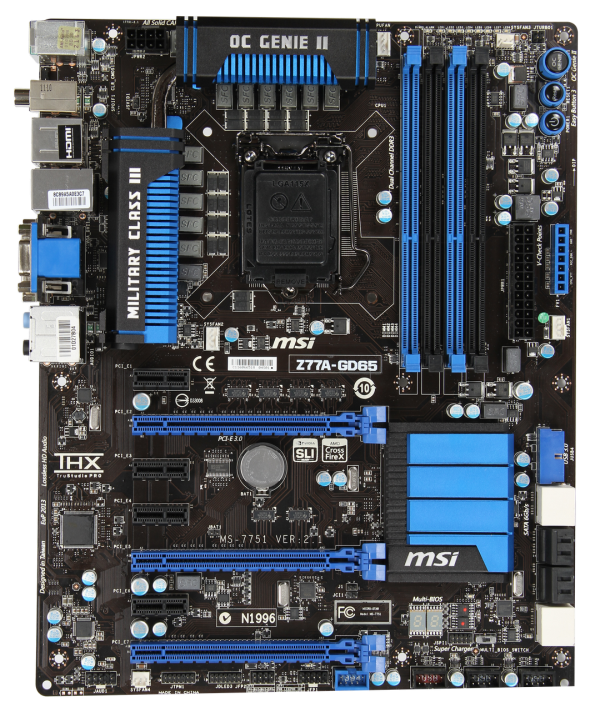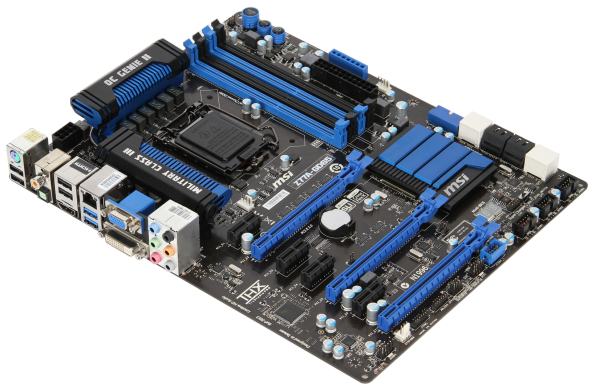Intel Z77 Panther Point Chipset and Motherboard Preview – ASRock, ASUS, Gigabyte, MSI, ECS and Biostar
by Ian Cutress on April 8, 2012 12:00 AM EST- Posted in
- Motherboards
- Intel
- Biostar
- MSI
- Gigabyte
- ASRock
- Asus
- Ivy Bridge
- ECS
- Z77
MSI Z77A-GD65—Visual Inspection
Whenever it comes to a motherboard comparison involving ASUS, Gigabyte or ASRock against an MSI board, the MSI board always tends to show a strong result—either in terms of price, performance or features. So when it comes to the new batch of motherboards for Ivy Bridge, it is fair to say that I expect a strong showing from MSI. For this preview, we have their Z77A-GD65, which will be one behind their future released GD80 that got attention back at CES for being Thunderbolt equipped.
The Z77A-GD65 is another motherboard in this roundup that comes in a black and blue livery. This time MSI have more of an excuse than others do as they have been using it for a fair while now. Using what is essentially a 10 + 2 phase power delivery, MSI are using somewhat beefier heatsinks than their rivals, connecting both via a heatpipe. The socket area is right up against Intel's minimum requirements from left to right, but there is some room to maneuver big air coolers from top to bottom. Around the socket there are at least four fan headers to use: one 4-pin CPU header between the top VRM and the memory slots, a 4-pin system fan header just the other side of the memory slots, a 4-pin to the bottom left of the socket area, and another 4-pin beside the 24-pin ATX power connector. A fifth fan header can be found at the bottom of the board.
Along the right hand side, we have the standard MSI trio of power/reset/OC Genie buttons, followed but a series of voltage checkpoints for overclockers. Aside from the 24-pin power connector and the system fan header, there is also a USB 3.0 header at right angles to the board, indicating its primary use is to the front of the case. Underneath this are the eight SATA ports—two SATA 6 Gbps from the PCH, four SATA 3 Gbps also from the PCH, and another two SATA 6 Gbps from an ASMedia controller.
As the power/reset/OC Genie buttons are at the top right, the bottom of the board has more room to fit in all the headers as needed—front panel audio, TPM, front panel headers and USB 2.0 headers. In terms of PCIe, MSI have done away with the PCIe to PCI bridge and focused purely on PCIe. We have an x1, x16 (x8 with dual GPU), x1, x1, x8, x1, and a PCIe 2.0 x4. In this instance, there is plenty of room for a dual GPU setup with PCIe slots to spare for any extras.
Also of note is the chipset cooler, which is very flat and large with minimal fins, perhaps suggesting that MSI is confident about their heatsink design. Underneath this is a two digit debug display, and a BIOS switch for changing between two BIOSes.
On the rear IO panel, I think MSI have been reasonable with what they have left in and what they have left out. From left to right, we have a combination PS/2 port, two USB 2.0 ports (black), a clear CMOS button, digital and coaxial SPDIF outputs, two more USB 2.0 ports (black), a HDMI port, gigabit Ethernet, two USB 3.0 ports (blue), D-Sub, DVI-D, and audio jacks.
Board Features
| MSI Z77A-GD65 | |
| Size | ATX |
| CPU Interface | LGA-1155 |
| Chipset | Intel Z77 |
| Power Delivery (CPU/iGPU) | 8 + 1 + 2 + 1 (VRM/VTT/GPU/SA) |
| Memory Slots |
Four DDR3 DIMM slots supporting up to 32 GB Up to Dual Channel, 1066-2667 MHz |
| Video Outputs | HDMI, DVI-D, D-Sub |
| Onboard LAN | Intel 82579V |
| Onboard Audio | Realtek ALC898 |
| Expansion Slots |
2 x PCIe x16 Gen3 (x16, x8/8) 1 x PCIe x16 Gen2 (x4) 4 x PCIe x1 Gen2 |
| Onboard SATA/RAID |
2 x SATA 6 Gbps (PCH), Support for RAID 0, 1, 5, 10 4 x SATA 3 Gbps (PCH), Support for RAID 0, 1, 5, 10 2 x SATA 6 Gbps (ASMedia ASM1061) |
| USB |
4 USB 3.0 ports (2 back panel, 2 from headers) 10 USB 2.0 ports (4 back panel, 6 from headers) |
| Onboard |
4 x SATA 6Gbps 4 x SATA 3 Gbps 1 x USB 3.0 Header 3 x USB 2.0 Headers 1 x IEEE1394 Header 1 x TPM Header 1 x Front Panel Audio Header Power/Reset Buttons OC Genie 5 x Fan Headers |
| Power Connectors |
1 x 24-pin ATX connector 1 x 8-pin 12V connector |
| Fan Headers |
1 x CPU Fan Header (4-pin) 4 x SYS Fan Headers (two 4-pin, two 3-pin) |
| IO Panel |
1 x Combo PS/2 Port 1 x Clear CMOS Button 1 x Coaxial S/PDIF Port 1 x Optical S/PDIF Port 4 x USB 2.0 2 x USB 3.0 1 x Gigabit Ethernet Audio Jacks 1 x HDMI 1 x DVI-D 1 x D-Sub |
| Warranty Period | 3 Years |
| Product Page | Link |
It is good to see an Intel NIC on this $180 MSRP motherboard. There are plenty of headers to go around. The only things missing where other motherboards may have better all-round functionality are a PCI slot, mSATA and on-board WiFi.













145 Comments
View All Comments
tyger11 - Sunday, April 8, 2012 - link
The article says only 2 USB 3.0 ports, but the table indicates 4. Which is correct?repoman27 - Sunday, April 8, 2012 - link
I didn't see your comment and posed a similar question, but I'm fairly certain the answer is that there are actually 4 SuperSpeed ports provided by the 7-series chipsets. If you look at the block diagram shown for the Intel DZ77GA-70K motherboard it looks like they clearly used two 3-port USB 3.0 hub chips to arrive at a total of 8 USB 3 ports. Which also brings up the point that by leveraging the integrated USB 3.0 capabilities, motherboard manufacturers can add as many USB 3.0 ports as they like by using far less expensive hub chips instead of full blown controllers which also require a PCIe lane apiece.And speaking of PCIe, I also wonder about where Ian says, "These are known as PCIe 3.0 PLX PXE chips..." I'm guessing that he's referring to PLX's PEX 874x Gen 3 PCIe switches, but it's stated a bit oddly.
landerf - Sunday, April 8, 2012 - link
Is the wifi card on the deluxe going to be accessible? Be nice to get a killer 1102 in there.johnpombrio - Sunday, April 8, 2012 - link
Yeah, the WiFi connection(s) on the ASUS Pro and Deluxe depends on a small WiFi module that plugs into a particular slot. These will be interchangeable AND I have seen ASUS showing off a WiFi/ 60GB SSD drive going into that slot. The Pro looks like just a receiver while the Deluxe has a WiFi router built in but I am REALLY guessing on this. I think I will go with the Deluxe just because it has a couple of features I like and the WiFi router combo will be just gravy.ASUSTechMKT - Monday, April 9, 2012 - link
Our MCombo Card ( which is on the Maximus V Gene and upcoming Formula should not be confused with the solution on our channel boards ( Standard -V, Pro or Deluxe ). The MCombo will allow you to install any MiniPCI-E or MSATA cards into their corresponding slots.ASUSTechMKT - Monday, April 9, 2012 - link
The module which connects to the back I/O panel can be opened. While not promoted as being DIY there is nothing stopping you from installing your own mini PCI-E wireless controller.AlexIsAlex - Sunday, April 8, 2012 - link
I know I've asked for this before, but if you're going to do a big roundup of all these motherboards (which I'm looking forward to, as I plan to upgrade to Ivy Bridge on release), then please please test the boot / POST times to compare between the boards!Just the time it takes from hitting the power switch to when it starts to actually run the bootloader off disk. Or until it displays the "please insert boot media" - the actual time the bios contributes to the total boot time. This is something that can really differentiate between different bios implementations and would be really useful to know when choosing.
I know having RAID and on board devices turned on make a big difference, so a baseline of everything non-essential turned off, or just those devices that are present on all boards would make sense.
Nihility - Sunday, April 8, 2012 - link
Seriously, please test POST times!Especially with the 6 Gbps Marvel controllers. Those damn controllers can take over 10 seconds to boot. That can easily be as much as the entire system.
risa2000 - Sunday, April 8, 2012 - link
I would be quite interested in this one.eXces - Sunday, April 8, 2012 - link
would be very pleased for an ITX review! Especially Asus P8Z77-I DeluxeThx